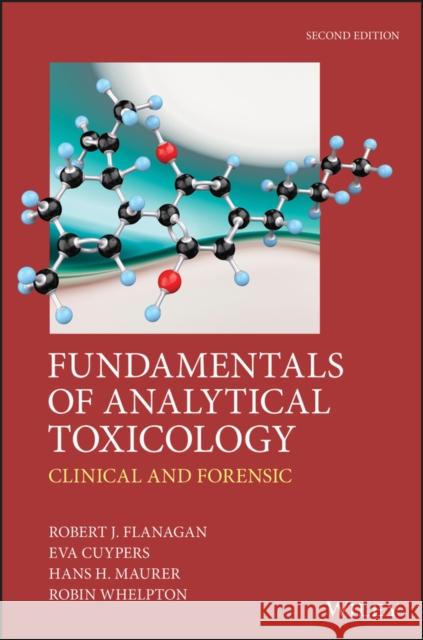Fundamentals of Analytical Toxicology: Clinical and Forensic » książka



Fundamentals of Analytical Toxicology: Clinical and Forensic
ISBN-13: 9781119122340 / Angielski / Twarda / 2020 / 648 str.
Fundamentals of Analytical Toxicology: Clinical and Forensic
ISBN-13: 9781119122340 / Angielski / Twarda / 2020 / 648 str.
(netto: 485,55 VAT: 5%)
Najniższa cena z 30 dni: 506,69
ok. 30 dni roboczych
Dostawa w 2026 r.
Darmowa dostawa!
Preface xxiiiHealth and Safety xxvNomenclature, Symbols, and Conventions xxviiUniform Resource Locators xxixAmount Concentration and Mass Concentration xxxiAcknowledgements xxxiiiList of Abbreviations xxxvSection A The Basics 11 Analytical Toxicology: Overview 31.1 Introduction 31.2 Modern analytical toxicology 41.3 Provision of analytical toxicology services 101.4 Applications of analytical toxicology 151.5 Summary 21References 212 Sample Collection, Transport, and Storage 232.1 Introduction 232.2 Clinical samples and sampling 232.3 Guidelines for sample collection for analytical toxicology 322.4 Sample transport, storage, and disposal 452.5 Common interferences 472.6 Summary 48References 483 Basic Laboratory Operations 523.1 Introduction 523.2 Aspects of quantitative analysis 583.3 Use of internal standards 743.4 Method comparison 783.5 Non-parametric statistics 803.6 Quality control and quality assessment 843.7 Operational considerations 893.8 Summary 91References 914 Aspects of Sample Preparation 944.1 Introduction 944.2 Modes of sample preparation 974.3 Plasma protein binding 1124.4 Hydrolysis of conjugated metabolites 1154.5 Extraction of drugs from tissues 1174.6 Summary 117References 1185 Colour Tests, and Spectrophotometric and Luminescence Techniques 1205.1 Introduction 1205.2 Colour tests in toxicology 1205.3 Colour tests for pharmaceuticals and illicit drugs 1225.4 UV/Visible spectrophotometry 1235.5 Fluorescence and phosphorescence 1345.6 Chemiluminescence 1385.7 Infrared and Raman spectroscopy 1415.8 Summary 143References 1436 Immunoassays and Related Assays 1456.1 Introduction 1456.2 Basic principles of competitive binding assays 1456.3 Heterogeneous immunoassays 1516.4 Homogenous immunoassays 1556.5 Microparticulate and turbidimetric immunoassays 1596.6 Assay calibration, quality control, and quality assessment 1606.7 Interferences and assay failures 1626.8 Aptamer-based assays 1636.9 Enzyme-based assays 1636.10 Summary 165References 166Section B Separation Science 1677 Separation Science: Theoretical Aspects 1697.1 General introduction 1697.2 Theoretical aspects of chromatography 1707.3 Measurement of analyte retention 1797.4 Summary 181References 1818 Planar Chromatography 1828.1 Introduction 1828.2 Qualitative thin-layer chromatography 1838.3 Quantitative thin-layer chromatography 1908.4 Summary 192References 1929 Gas Chromatography 1939.1 Introduction 1939.2 Instrumentation 1949.3 Columns and column packings 2039.4 Headspace and 'purge and trap' analysis 2109.5 Formation of artefacts in gas chromatography 2139.6 Derivatization for gas chromatography 2139.7 Chiral separations 2179.8 Summary 219References 22010 Liquid Chromatography 22310.1 Introduction 22310.2 General considerations 22410.3 Detection in liquid chromatography 23210.4 Columns and column packings 24010.5 Modes of liquid chromatography 24510.6 Chiral separations 25010.7 Derivatives for liquid chromatography 25510.8 Use of liquid chromatography in analytical toxicology 25610.9 Summary 261References 26211 Supercritical Fluid Chromatography 26411.1 Introduction 26411.2 General considerations 26711.3 Detection in supercritical fluid chromatography 26911.4 Columns and column packings 26911.5 Chiral separations 27011.6 Toxicological and forensic applications 27211.7 Summary 273References 27312 Capillary Electrophoretic Techniques 27512.1 Introduction 27512.2 Theoretical aspects 27612.3 Sample injection in capillary electrophoresis 28012.4 Detection in capillary electrophoresis 28112.5 Other capillary electrokinetic modes 28212.6 Capillary electrophoretic techniques in analytical toxicology 28512.7 Summary 287References 28713 Mass Spectrometry 28913.1 Introduction 28913.2 Instrumentation 29113.3 Gas chromatography-mass spectrometry 29913.4 Liquid chromatography-mass spectrometry 30413.5 Supercritical fluid chromatography-mass spectrometry 30813.6 Capillary electrophoresis-mass spectrometry 30913.7 Direct introduction mass spectrometry 31013.8 Presentation of mass spectral data 31513.9 Interpretation of mass spectra 31713.10 Quantitative mass spectrometry 32013.11 Mass spectrometry imaging 32413.12 Summary 325References 32514 Ion Mobility Spectrometry 32914.1 Introduction 32914.2 Theoretical aspects 33114.3 Types of ion mobility spectrometry 33214.4 Resolving power 33614.5 Interfacing ion mobility spectrometry 33614.6 Applications of ion mobility spectrometry in analytical toxicology 33914.7 Summary 342References 342Section C Essential Pharmacokinetics 34515 Absorption, Distribution, Metabolism, and Excretion of Xenobiotics 34715.1 Introduction 34715.2 Movement of drugs and other xenobiotics around the body 34715.3 Routes of administration 35115.4 Distribution 35515.5 Metabolism 35715.6 Excretion 37115.7 Pharmacogenetics and pharmacogenomics 37315.8 Summary 376References 37716 Pharmacokinetics 37916.1 Introduction 37916.2 Fundamental concepts 37916.3 Absorption and elimination 38216.4 Drug accumulation 38416.5 Sustained-release preparations 38616.6 Non-linear pharmacokinetics 38716.7 Multi-compartment models 39016.8 Non-compartmental methods 39216.9 Factors affecting pharmacokinetic parameters 39316.10 Disease 39616.11 Pharmacokinetics and the interpretation of results 39716.12 Summary 402References 402Section D Analytical Toxicology 40517 Toxicology Testing at the Point of Contact 40717.1 Introduction 40717.2 Use of point of contact testing 40817.3 Toxicology testing at the point of contact 41217.4 Interferences and adulterants 41817.5 Quality assessment 41917.6 Summary 419References 41918 Laboratory Testing for Substance Misuse 42218.1 Introduction 42218.2 Urine testing 42518.3 Oral fluid testing 43318.4 Blood testing 43718.5 Hair testing 43818.6 Breath testing 44518.7 Sweat testing 44618.8 Summary 446References 44719 General Analytical Toxicology 45219.1 Introduction 45219.2 Gas chromatography 45319.3 Gas chromatography-mass spectrometry 45619.4 Liquid chromatography 46419.5 Liquid chromatography-mass spectrometry 46419.6 Liquid chromatography-high resolution mass spectrometry 46919.7 Summary 473References 47520 Therapeutic Drug Monitoring 47920.1 Introduction 47920.2 Sample collection 48020.3 Sample types 48120.4 Analytical methods 48320.5 Factors affecting interpretation of results 48520.6 Gazetteer 48620.7 Summary 499References 49921 Trace Elements and Toxic Metals 50521.1 Introduction 50521.2 Sample collection and storage 50521.3 Sample preparation 50721.4 Atomic spectrometry 50921.5 Colorimetry and fluorimetry 52021.6 Electrochemical methods 52121.7 Catalytic methods 52321.8 Neutron activation analysis 52321.9 Chromatographic methods 52421.10 Quality assessment 52521.11 Summary 525References 52522 Clinical Interpretation of Analytical Results 52722.1 Introduction 52722.2 Clinical toxicology 52922.3 Forensic toxicology 53322.4 Gazetteer 53922.5 Sources of further information 57422.6 Summary 576References 576Index 587
Robert J Flanagan, Precision Medicine, King's College Hospital NHS Foundation Trust, UK, and Specialised Clinical Chemistry, Sheffield Teaching Hospitals NHS Foundation Trust, UK.EVA CUYPERS, Maastricht Multimodal Molecular Imaging Institute, University of Maastricht, The Netherlands, and KU Leuven Toxicology and Pharmacology, Belgium.HANS H. MAURER, Department of Experimental and Clinical Toxicology, Saarland University, Germany.ROBIN WHELPTON, Formerly School of Biological and Chemical Sciences, Queen Mary University of London, UK.
1997-2025 DolnySlask.com Agencja Internetowa
KrainaKsiazek.PL - Księgarnia Internetowa









